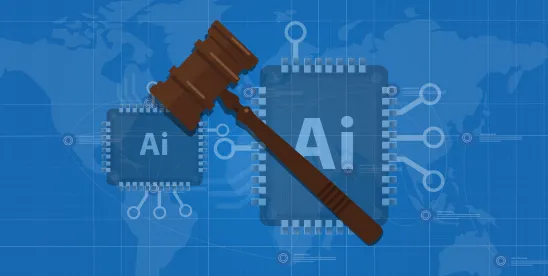On September 24, 2024, the U.S. Department of Labor (“DOL”), collaborating with the Partnership on Employment & Accessible Technology (“PEAT”), a non-governmental organization the DOL funds and supports, announced the publication of the “AI & Inclusive Hiring Framework,” (“the DOL’s Framework”).
The DOL’s Framework, created in response to the Biden-Harris Executive Order on the Safe, Secure, and Trustworthy Development and Use of Artificial Intelligence, helps employers create and maintain non-discriminatory artificial intelligence (“AI”) hiring procedures for job seekers with disabilities. (For more information on the Biden-Harris Executive Order, see our Workforce Bulletin.)
Establishing these procedures has become a top priority for employers as nearly 1 in 4 organizations have implemented AI tools in human resource departments, according to new research from SHRM.
AI-powered recruitment and selection tools can streamline the hiring process by identifying potential candidates or screening applicant resumes, but employers must ensure their AI hiring tools do not intentionally or unintentionally perpetuate discriminatory practices or create barriers for job seekers with disabilities. Employers may rely on the DOL’s Framework as a useful starting point when implementing AI hiring tools. Employers that have already implemented such tools should review the DOL’s Framework to ensure their practices do not create unwanted liability.
The DOL’s Framework expands the same themes of responsible and transparent AI use published by the DOL earlier this year. (For more information on the DOL’s principles for workplace AI, see our Workforce Bulletin.) The DOL’s Framework outlines goals for employers using AI hiring tools and suggests sample activities to help monitor and improve internal AI hiring tool usage to foster inclusive procedures.
Development
PEAT consulted with disability advocates, employers, AI experts, and government and industry leaders, to apply the pre-existing National Institute of Standards and Technology’s AI Risk Management Framework to the specific issues facing employers and job seekers with disabilities. The DOL’s Framework identifies ten focus areas, set forth below, meant to address the impact AI technologies could have on recruitment and hiring of job seekers with disabilities, while maximizing the potential benefits offered by these technologies.
The DOL’s Framework
The DOL’s Framework comprises ten focus areas:
Identify Legal Requirements
- Be aware of existing and emerging federal, state, and local regulations surrounding the use of AI in hiring practices;
- Working with counsel, create non-discriminatory procedures and policies compliant with the current legal landscape, and develop internal training procedures to ensure employees and applicants are properly apprised of the proper use of AI in the hiring process;
- Ensure AI policies sufficiently protect privacy risks concerning personally identifiable information and personally sensitive information by monitoring how AI technologies collect such data; and
- Ensure AI does not adversely impact workers because of their protected attributes.
Establish Staff Roles
- Define and assign roles within the organization to ensure AI recruiting tools are used with proper oversight;
- Train staff on the risks of AI hiring technology; and
- Seek diverse opinions from organizations and individuals with disabilities concerned with fair hiring in the workplace.
Inventory and Classify Technology
- Train employees on how AI recruitment tools work, and where human oversight may be needed; and
- Specify tasks for which employees should or should not use AI tools.
Work with Responsible Vendors
- Conduct due diligence on and work with third-party vendors to ensure risk mitigation steps were taken during the development of AI recruitment tools;
- Ask vendors:
- how they addressed unlawful bias during the development of AI tools,
- whether they developed an accessible user interface for job seekers with disabilities, and
- if they will provide materials in alternative formats for those seeking accommodations;
Note that the importance of working with compliant vendors has come to the forefront as courts have begun to analyze whether third-party AI candidate screening tools are agents of the employer. If such tools are considered an employer’s agent, the employer could be subject to liability for the vendor’s actions.
Assess Impacts
- Consider whether the risk of AI recruitment tools exceeds the benefits;
- Develop methods to assess how AI affects recruitment and selection generally and protected classes particularly; and
- Consider using independent assessors, such as counsel, to make sure programs are legally compliant.
Provide Accommodations
- Create a reasonable accommodation request process;
- Ensure that job seekers know how to request reasonable accommodations whether AI recruitment tools are used or not; and
- Train employees on the accommodations process, particularly with respect to AI tools.
Use Explainable AI
- Provide accessible and easily understood notices to inform job seekers:
- that the organization is using AI in the recruitment and selection process,
- how the organization is implementing AI hiring tools; and
- Explain internal oversight procedures.
Ensure Human Oversight
- Create internal policies to define when the use of AI tools is permissible; and
- Confirm the organization has sufficiently trained employees to properly interpret AI model outputs so they may detect and prevent bias.
Manage Incidents
- Develop procedures on how to respond to incidents; and
- Create contingency policies to implement in the event the risk of the AI hiring technology becomes too great.
Monitor Regularly
- Routinely evaluate the benefits and risks of AI-recruitment and selection tools with counsel;
- Consider feedback and recommendations from internal and external diverse stakeholders, including individuals with disabilities; and
- Analyze the effectiveness of accommodations provided.
Takeaways
The DOL’s Framework and ten focus areas are not legally binding and largely expand on previously issued federal guidance. Nonetheless, employers should work with counsel to consistently monitor legal developments regarding AI and may consult the DOL’s Framework when considering purchasing and/or implementing a new AI hiring tool, or when creating oversight policies for already implemented tools, to ensure hiring policies stay legally compliant and discriminatory impacts are avoided or mitigated.
*Gretel Zumwalt, a Law Clerk – Admission Pending in Epstein Becker Green’s New York office, contributed to this article.






 />i
/>i

